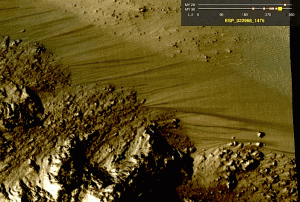The features known as “recurring slope lineae” (RSL) are the best evidence going that liquid water can, and does, flow on present-day Mars. The lineae are small dark streaks that appear mostly on equator-facing slopes, are associated with slope channels, and occur during local spring and summer before fading and disappearing during autumn and winter.

DRIP, DRIP, DRIP. Dark streaks creep downhill during Martian spring and summer at certain locations. New research shows how these "recurrent slope lineae" can form and flow as liquid brines composed of magnesium- and calcium-chloride salts. (NASA/JPL-Caltech/University of Arizona)
According to a new paper in Geophysical Research Letters, the case for lineae being current-day flows of liquid is now stronger. Vincent Chevrier (University of Arkansas) and Edgard Rivera-Valentin (Brown University) write that they modeled the behavior under Martian atmospheric pressure conditions and temperatures of pure water and brines with varying mineral compositions and freezing temperatures that ranged from 273 kelvin (0°C, 32°F) down to 206 Kelvin (-67°C, -89°F).
Chevrier notes, “We used salts that have been indentified on Mars, or inferred from various models or observations. Salts with higher temperatures of freezing/melting are too unstable, and those with lower temperatures are too stable. They are almost always melted and thus could not form episodic flows.”
The researchers conclude, “Our results suggest that a solution with a freezing temperature of about 223 Kelvin [-50°C, -58°F] can best reproduce the observed seasonality.” In addition, they note that although most brines and even pure water could produce the lineae, salts such as magnesium and calcium chlorides are the best candidates to produce episodic seasonal melting.
“Relatively high surface evaporation rates at the lineae locations make the flows disappear over a single season,” the scientists say. The temperatures at which the brines can flow largely rule out slopes that face poleward — they’re just too cold.
The researchers add that the model “requires the presence of buried ice within the regolith column, which in the southern hemisphere is only considered stable for latitudes greater than 40° south.” And they note that the lineae “may indicate that a recharge mechanism is active in order to maintain a source of brine over even short geological timescales, which would have important implications for the Martian water cycle.”
Once melting occurs in the subsurface, either liquid-dominated or triggered flows are possible under present-day conditions provided they are made of concentrated salt solutions.
Yet a problem with brines as the flowing liquid has been the lack of spectroscopic evidence from orbit. The answer, the scientists suggest, lies in the high evaporation rates. “High surface evaporation explains why the lineae disappear relatively quickly and why MRO‘s Compact Reconnaissance Imaging Spectrometer for Mars (CRISM) could not identify water signatures.”
CRISM, the scientists note, “is sensitive down to about 100 micrometers’ [= 0.1 millimeter] depth. It would take only a few hours for liquid brines to evaporate down to such a depth. Therefore, unless the instrument caught the liquid while flowing, there is only a small chance for the signal to show any evidence of liquid water.”








